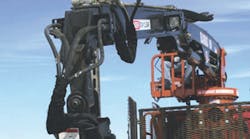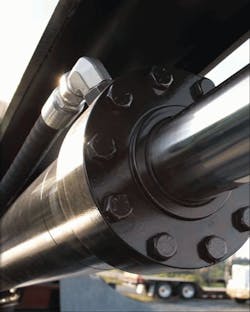Barko Hydraulics, Superior, Wis., says its 80XL back-of-cab knuckleboom loader delivers the highest payload with the lowest installed weight ratio and provides the lowest cost of operation of any product on the market. It also comes equipped with more standard features and is said to last longer and perform harder than its competitors.
These are some pretty bold claims, but a look at the 80XL’s hydraulic system provides some serious backup. For starters, hydraulic cylinders are fitted with spherical rod-end bearings and wear rings on glands and pistons to ensure long life. All cylinders are made of heavy wall honed steel tubing and have heat-treated piston rods with heavy chrome plating for low friction and high wear resistance. Main and stick boom cylinders have induction hardened rods and bolt on glands.
The main boom cylinder has a 5-in. (127 mm) bore with a 36-in. (914.4 mm) stroke and 3-in. (76.2 mm) diameter piston rod. The stick boom cylinder has a 5-in. (127 mm) bore, 30-in. (762.0 mm) stroke, and 21⁄2-in. (63.5 mm) rod.
A truck’s power takeoff drives three tandem mounted gear pumps in the 80XL’s hydraulic power unit, which also contains a 45-gal (170 l) reservoir. When driven at 1500 rpm from the PTO, the main pump delivers 26 gpm (98 lpm) of fluid, and the other two deliver 21 and 15 gpm (79 and 57 lpm), respectively, at pressures to 3200 psi (200 bar). The operator controls lifting and movement through fine-control mechanical joysticks that actuate proportional sectional valves. Hydraulic lines throughout the machine use either heavy-wall tubing or 4-wire hose.
In the swing of things
The 80XL also features a swing drive for continuous 360° rotation. Because it is driven by the truck’s PTO, the 80XL’s hydraulic power unit is stationary, so a means must be provided to route hydraulic fluid between the hydraulic power unit and the grapple arm. This is accomplished using a 5-port rotating manifold.
The swing drive itself is powered by a hydraulic motor driving a single-stage planetary gear speed reducer to a 27-in. (685.8 mm) external tooth turntable bearing. The operator controls the swing function through a foot pedal that actuates a valve mounted under the seat. The operator’s platform rotates with the crane arm, so the operator always has a clear view of the load and grapple arm for safe operation.
Another solution
And speaking of safety, the Model 24562 truck-mounted loader from Iowa Mold Tooling Co. Inc., Garner, Iowa, takes full advantage of hydraulics for its inherently safe operation. All cylinders on the 24562 are equipped with integral mounted load-holding valves on all load bearing functions. These valves prevent cylinders from retracting suddenly in the event of a hose or other hydraulic system failure.
Outrigger cylinders use pilot-operated check valves to prevent unintentional retraction. However, inner, outer and extension boom cylinders use counterbalance valves for their smoother controllability. The counterbalance valve controls lowering and allows that motion to be feathered while under load. The inner and outer cylinders have an additional relief valve for protection if the load limiting device malfunctions.
The swing drive uses a rack-and-pinion arrangement powered by single acting cylinders to provide rotation of 420°. A counterbalance valve on each cylinder acts as a brake to stop motion in the event of a valve or piping failure. The rack-and-pinion is encased in a continuous oil bath to reduce friction and enhance the gear and bearing life.
The 24562’s open-center hydraulic system is powered by a pair of 16-gpm (60 lpm) tandem pumps at pressure of 4279 psi (295 bar). Control system consists of two three-spool, stack-type valve banks. All handler functions are controlled through joysticks.
Additional safety is provided by the handler’s rated capacity limitation (RCL) system. The basic configuration includes the electronic controller, dump valve, pressure transducer, and spool sensor. The system constantly monitors the machine’s load moment, operation, and function. If an overload occurs, the system warns the operator and blocks oil flow to the various actuators. However, load moment reducing functions can still be operated.
For more on Barko’s 80XL, visit www.barko.com or call (715) 392-5641.
For information on IMT’s 24562, visit www.imt.com or call (800) 247-5958.




